
WHAT ARE BRIDGES?
The fixed partial denture is a prosthetic appliance, permanently attached to remaining teeth, which replaces one or more missing teeth. This type of restoration has long been called a “Bridge”.

Some other important terms…
The abutment is any tooth, root or implant which gives attachment and support to the fixed partial denture.
The retainers, are extra-coronal restorations that are cemented to the prepared abutment teeth.
A pontic, is the artificial tooth replacing the missing tooth in the fixed prosthesis. Pontics are attached to the retainers.

The connectors are the portions of the bridge uniting the individual parts of the bridge (pontic and retainer). They may be rigid (solder joints or cast connectors) or non-rigid (precision attachments or stress breakers).

A span is the space between natural teeth that is to be filled by the bridge.
A unit, when applied to bridgework, means either a retainer or a pontic. A bridge with two retainers and one pontic would therefore be a three-unit bridge.
Conventional and minimal preparation bridges
Conventional bridges involve removing tooth tissue, or a previous restoration, and replacing it with a retainer.
The alternative, minimal-preparation bridge involves attaching pontics via a metal plate to the unprepared (or minimally prepared) lingual surfaces of adjacent teeth. The attachment is made by a composite resin material, retained by the acid-etch technique to the enamel. They are called also known as resin-bonded bridges.
Ante’s Law
The combined pericemental area (root surface area) of all abutment teeth supporting a fixed dental prosthesis should be equal to or greater in pericemental area than the tooth or teeth to be replaced.
Ante IH. The fundamental principles, design and construction of crown and bridge prosthesis. Dent Item Int 1928;50:215-32.
The Four Basic Bridge Designs
- Fixed-fixed bridge.
- Fixed-movable bridge.
- Cantilever bridge.
- Spring cantilever bridge.
A) Fixed-fixed Bridge
A fixed-fixed bridge has a rigid connector at both ends of the pontic. The abutment teeth are therefore rigidly splinted together, and for a conventional bridge must be prepared parallel to each other so that the bridge, which is a minimum of three units, can be cemented in one piece.
The retainers should have approximately the same retention as each other to reduce the risk that forces applied to the bridge will dislodge one retainer from its abutment, leaving the bridge suspended from the other abutment.
To minimize this risk, it is also important for the entire occluding surface of all the abutment teeth for a conventional bridge to be covered by the retainers.
The opposing teeth cannot then contact the surface of an abutment tooth, depress it in its socket and break the cement lute.

Advantages
- Robust design with maximum retention and strength.
- The construction is relatively straight-forward in the laboratory because there are no movable joints to make.
- Can be used for long spans.
Disadvantages
- Requires preparations to be parallel.
- Has to be cemented in one piece, so cementation is difficult.
B) Fixed-movable Bridge

A fixed-movable bridge has a rigid connector, usually at the distal end of the pontic, and a movable connector that allows some vertical movement of the mesial abutment tooth .

Advantages
- Preparations do not need to be parallel to each other.
- More conservative of tooth tissue because preparations for minor retainers are less destructive than preparations for major retainers.
- Allows minor movements of teeth.
- Parts can be cemented separately, so cementation is easy.
Disadvantages
- Length of span limited.
- More complicated to construct in the laboratory than fixed-fixed.
- Difficult to make temporary bridges.
C) Cantilever Bridge

A cantilever bridge is a fixed partial denture that attaches to adjacent teeth on one side of the bridge only.
Advantages
- The most conservative design when only one abutment tooth is needed.
- Construction in the laboratory is relatively straight-forward.
- Most suitable in replacing anterior teeth, where there is little risk of the abutment tooth tilting.
Disadvantages
1.The length of span is limited to one pontic.
- The construction of the bridge must be rigid to avoid distortion.
- Occlusal forces on the pontic of small posterior bridges encourage tilting of the abutment tooth.
D) Simple Cantilever Bridge

A cantilever bridge provides support for the pontic at one end only. The pontic may be attached to a single retainer or to two or more retainer(s) splinted together. but has no connection at the other end of the pontic.
E) Spring Cantilever Bridge

Spring cantilever bridges are restricted to the replacement of upper incisor teeth. Only one pontic can be supported by a spring cantilever bridge.
This is attached to the end of a long metal arm running high into the palate and then sweeping down to a rigid connector on the palatal side of a single retainer or a pair of splinted retainers.
The arm is made long and fairly thin so that it is springy. but not so thin that it will deform permanently with normal occlusal forces.
Forces applied to the pontic are absorbed by the springiness of the arm and by displacement of the soft tissues of the palate.
The abutments are usually the two premolar teeth splinted together, or a single premolar or molar tooth.
Combination designs
The four basic designs can be combined in a variety of ways. In particular, the fixed- fixed and cantilever designs are often combined. Similarly, it is possible to combine fixed-fixed and fixed-movable designs.

Hybrid design
This term refers to a bridge with a combination of conventional and minimal-preparation retainers.

Minimal preparation bridges or Resin‑bonded bridges consist of a metal framework with a pontic tooth with wing-like extensions coming from the proximal sides.

These metal wings are prepared to have a porous surface so that they can receive a bonding agent, and then the wings are bonded to the back sides of the teeth on either side of the missing tooth.
Examples of minimal-preparation bridge:
Macro-mechanically retentive bridges (Rochette). have large undercut perforations through the cast-metal plate. through which the composite resin cement flows.

Medium-mechanical retentive systems. all involve retentive features cast as part of the metal framework.

Micro -mechanical retention (Ex, Maryland Bridge) is produced by casting the metal retainer and then etching the fit surface by one of two methods: electrolytic etching in acid in the laboratory or chemical etching with a hydrofluoric acid gel either in the laboratory or at the chairside.

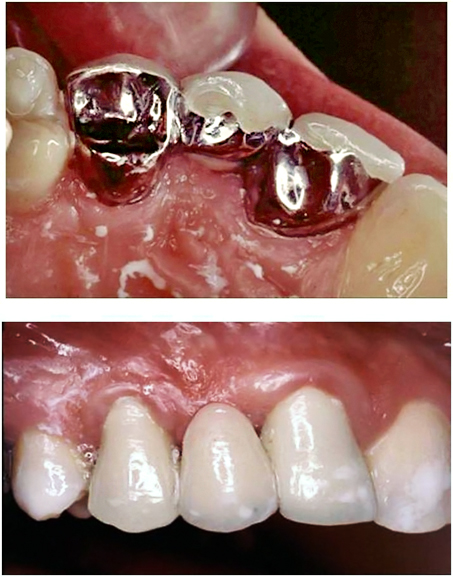
Reasons for Bridge Failure
- Loss of retention
- Mechanical failure
- Abutment failure
- Design failure
A) Loss of Retention
- One of the more common ways in which they fail is by one of the retainers becoming loose from the abutment tooth.
- Caries develops rapidly across the whole of the dentin surface of the preparation when there is a gap between the bridge retainer and unprepared tooth surface.
- It happens if the preparation is not adequately retentive. However, it may be possible to provide additional retention.
- Alternatively it may be necessary to include additional abutment teeth in a bridge to increase the overall retention or to change the design in some other way.
B) Mechanical failure of crowns or bridge components
Typical mechanical failures are:
- Porcelain fracture
- Failure of solder joints
- Distortion
- Occlusal wear and perforation
- Lost facings
Porcelain fracture
Pieces of porcelain fracturing off metal-ceramic crowns, or the loss of the entire facing due to failure of the metal-ceramic bond.
Failure of Solder Joint
Occasionally a solder joint that appears to be sound fails under occlusal loading. This may be due to:
- A flaw or inclusion in the solder itself.
- The solder joint not being sufficiently large for the conditions in which it is placed.
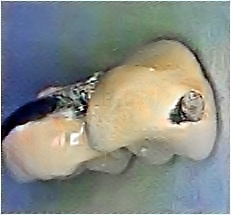
Distortion
In metal-ceramic bridges distortion of the framework can occur during function or as a result of trauma.
Occlusal wear and perforation
Perforation can be the result of normal wear.
Lost facings
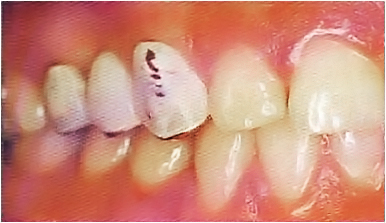
It can be re-placed and are reasonably satisfactory and less costly alternative to replacing the whole restoration.
C) Changes in the Abutment Tooth
- Periodontal disease
- Problems with the pulp
- Caries
D) Design Failures – inadequate bridge design
 A) Under-prescribed bridges
A) Under-prescribed bridges
These include designs that are unstable or have too few abutment teeth.
Another ‘under-design’ fault is to be too conservative in selecting retainers.
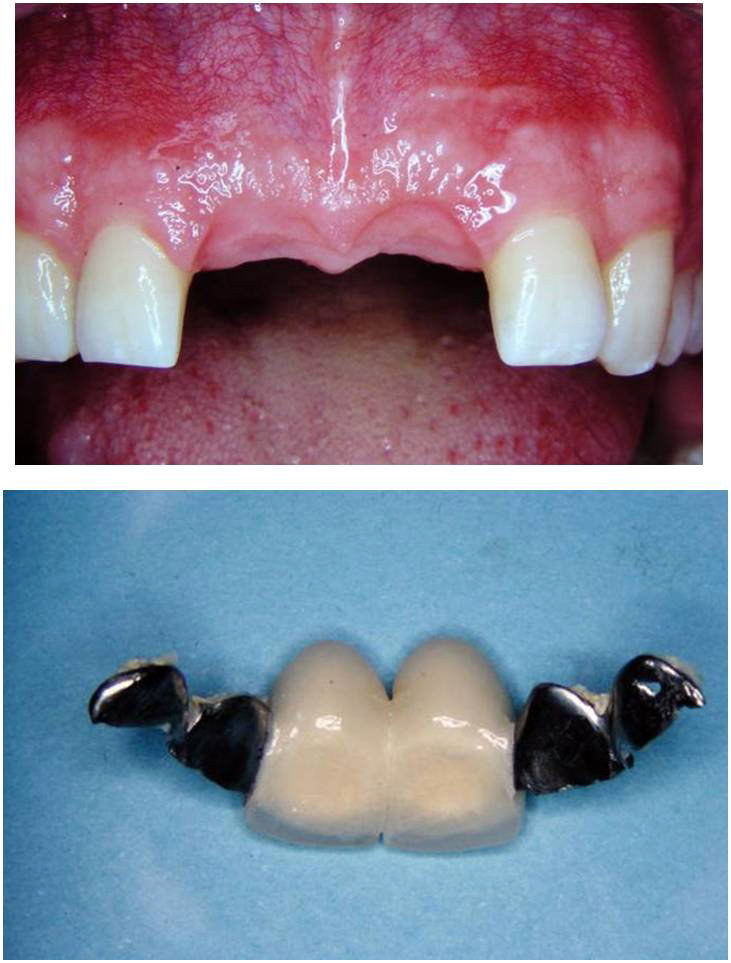
B) Over-prescribed bridges
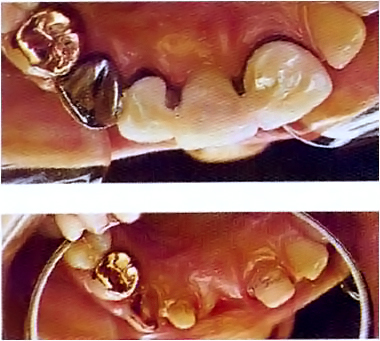
Where it includes more abutment teeth than are necessary.
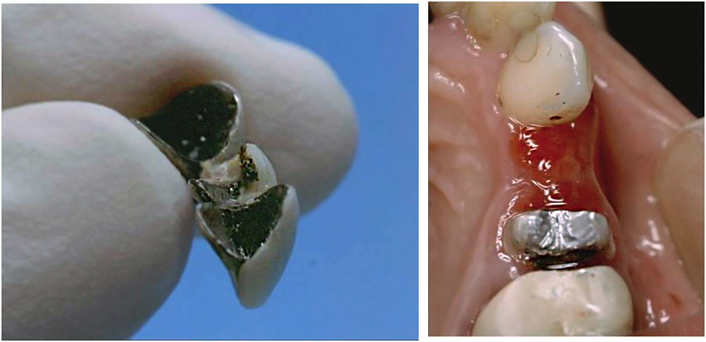
- Example of a poor pontic design
– end –